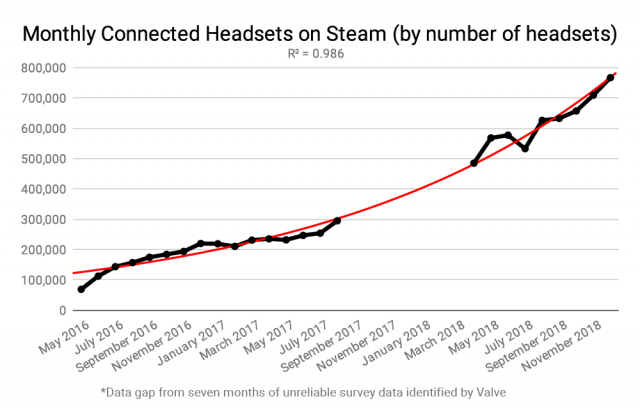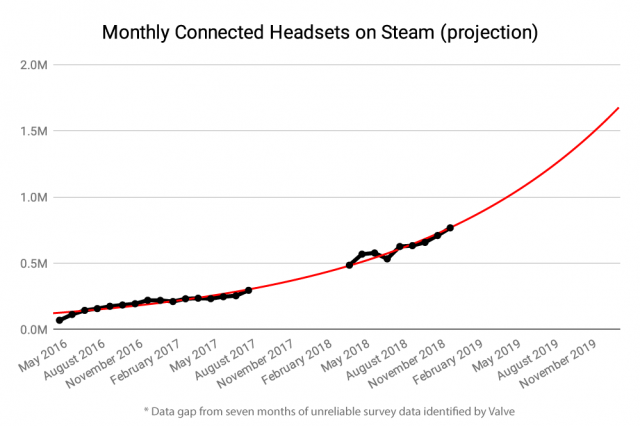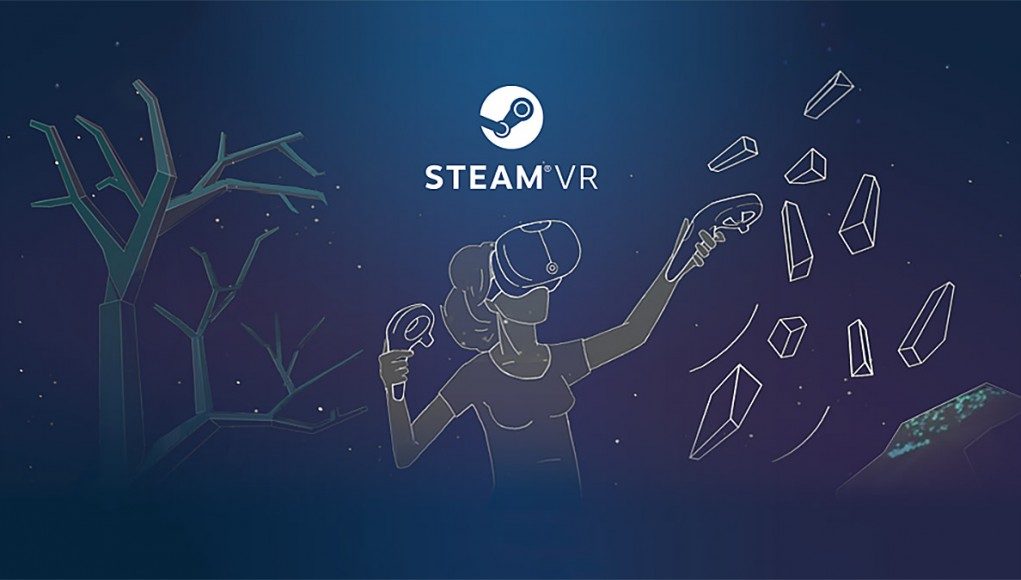Valve’s monthly Steam Survey has long offered some useful insight into which headsets are actively connected to users computers and the share of the Steam population that’s using each, but the figures provided are relative to the non-static Steam population, which obfuscates the actual adoption trend of VR headsets on the platform. To demystify the data, Road to VR has created a model which derives actual headset counts by correcting for Steam’s changing population. The result reveals a trend of headset adoption that’s a near perfect exponential growth curve.
Each month, Valve runs a survey among Steam users to determine some baseline statistics about what kind of hardware and software is used by the platform’s population, and to see how things are changing over time; that includes which VR headsets are connected to users’ computers. Participation in the survey is optional, and headsets aren’t counted if they aren’t connected and powered on at the moment that the data is collected.
While the survey has been a useful way see which headsets are most popular among those using them on Steam, the trend of all headsets on Steam has always been obfuscated because the data points given are exclusively percentages relative to Steam’s population, which itself is an unstated and constantly fluctuating figure.
That is to say, even if the percent of headsets in use on Steam as given by the survey was static month after month, the actual number of headsets in use on Steam would still be changing in proportion to Steam’s changing user population.
Road to VR maintains a detailed log of VR data from the Steam Survey dating back to April 2016, the month that the first consumer VR headsets launched. With help from our friends at VR/AR intelligence firm Greenlight Insights, we’ve created a model based on the historical data, along with official data points directly from Valve and Steam, which corrects for Steam’s changing population by estimating the actual count—not the percent—of users on Steam with connected VR headsets.

After correcting for Steam’s changing population, the result shows an adoption trend which closely fits mathematically exponential growth, with an R² value of 0.986, starting from the month that the first consumer headsets hit the market.
The result also shows that growth in the actual number of VR headsets is greater than has been recently reported; having grown by 160% from April 2017 (294,800 headsets) to December 2018 (766,862 headsets).
Worth noting about the results: we’re talking about monthly connected headsets here, as the underlying Steam Survey data is a snapshot of activity for each month. In the case of VR headsets, that means that the figure we’re estimating is how many unique headsets are connected to Steam users’ PCs over the course of a given month; it’s the closest official data point we have to active headsets, but doesn’t tell us the extent to which those headsets are actually being used.
Furthermore, the Steam Survey comes from a sample of the user population, not a comprehensive count, though Valve maintains the data offers an accurate snapshot. And of course, these figures are only inclusive of Steam, and don’t offer a complete picture of activity on Oculus’ platform (as some or any picture at all of Sony’s PlayStation VR.
It’s not clear how long this trend will continue, but we can make a (naive) projection based on what we’re seeing today, which suggests some 1.5 million monthly active headsets by the end of 2019.

Of course this projection is purely drawing out the exponential line, and doesn’t attempt to account for an array of other factors: crucially, in a young market like VR, things like cost, new features, and innovative content (or lack thereof) stand to influence the trend in significant ways.
Update (January 30th, 2019): Further clarified that the projection chart is just to see where the curve is heading when you draw out the exponential line; it should not be taken as a forecast. To prevent people from referencing the chart alone with none of the stated assumptions, we’ve also reduced the projection timeline from three years into the future to just one.







